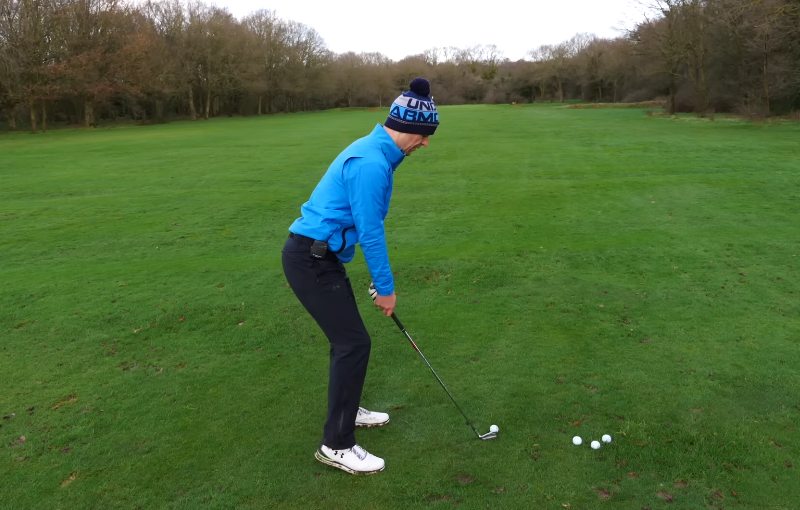
Imago
@DanielMaude/YouTube

Imago
@DanielMaude/YouTube
Backspin on a chip shot—this is the magic trick every golfer wants to master. If you learn it right, you can drop your chip shots near the flag, watching them as they almost instantly check up. But if you swing blindly, without following the exact steps, your ball will be running past the target, giving you nothing but frustrating second putts. You might think this trick is reserved just for the Tour pros, but this is far from the truth.
Watch What’s Trending Now!
Backspin on chip shots is a combination of the right equipment, proper setup, and a good, deliberate technique. In simple words, anyone can master it with a little bit of practice. Don’t worry, you have come to the right place. By the time you’ve finished this article, you can confidently flex that spin shot among your golfing friends.
Top Stories
Max Homa Comes Clean on Past Tensions With Justin Thomas: ‘Hated Each Other’

‘Taken Too Early’: Phil Mickelson Honors Late Golf Great 21 Years After His Demise

How Good Is Charlie Woods at Golf? John Daly, Phil Mickelson & More Give Their Verdicts

What Happened to Golf Creator Brad Dalke’s Wife? Health Update Revealed

R&A Breaks the Open’s 90-Year-Old Tradition to Avoid Olympics Clash

ADVERTISEMENT
1. Start with the right equipment
Of course, you cannot get a spin without a ball. That’s the most basic thing. But here’s the trick. You can’t achieve this backspin with any ball that you find in your backyard. Soft-cover golf balls, especially those designed for short game control, are key.
Backspin comes from the friction between the clubface and the ball. Distance-oriented balls have hard covers that resist deformation. That means the grooves on your wedges can’t grip the ball effectively. This will make that backspin of yours almost impossible.
What you can do is opt for balls with a urethane cover, like Bridgestone Tour B or Titleist Pro V1. These balls respond to your wedges’ grooves. This is simple physics, but it’s crucial for achieving that backspin chip shot.
ADVERTISEMENT
Next up is the club. You need to choose a club that will complement your ball. Keep in mind that loft is the magic ingredient here. The more loft you have at impact, the easier it will be to impart the backspin. A sand wedge (56°), lob wedge (58°), or even a 60° wedge will give you the angle you need.
View this post on Instagram
ADVERTISEMENT
It’s not just the loft that is essential. The condition of your clubface is equally important. As said before, the spin will generate due to the friction between the ball and the clubface. Clean, sharp grooves will give you a desirable friction. But if your wedges are worn down or caked in grass or sand or borrowed from your brother’s garage, the spin will be reduced dramatically.
That’s why you should always clean your club before hitting a chip shot and consider keeping a dedicated wedge for shots where spin is critical.
ADVERTISEMENT
2. Understand ball position and strike point
The next step is to know where to place your ball in your stance. This makes a big difference. For most standard chips, positioning the ball slightly back in your stance gives clean contact and controlled rollout. For shots where you want more spin, moving the ball slightly forward encourages a steeper angle of attack. You want to strike the ball near the bottom rather than the middle or side of the clubface. Hitting lower on the ball will increase effective loft at impact, which will convert into more spin.
3. Maintain a forward hand position
A common mistake that many amateur golfers make is letting their hands lag at impact. If you want that backspin, your hands should be slightly forward relative to the ball when you strike. This forward position is the one that will help you deliver a descending blow without scooping or flipping. Think of it as leading the clubface through the ball rather than letting the ball meet the clubface on its own. This technique will make the grooves dig into the ball properly and will generate the desired friction.
ADVERTISEMENT
4. Control clubhead speed
Among all these techniques and positions, don’t forget the speed. Once you have gotten the correct posture, with a good grip, the next thing you would want is to swing the club at an appropriate speed. The faster the clubface moves through the ball at impact, the more revolutions you will be able to impart. But remember, speed does not mean wildly swinging the club.
Controlled acceleration through the ball is essential. If you are too slow, the ball will just roll out. And if you are too fast, without control, your ball will overshoot. Just be accurate while maximizing the spin.
ADVERTISEMENT
5. Use the bounce effectively
This is the last factor to keep in mind and the most underrated. The bounce of your wedge, which is the angle between the leading edge and the sole, can make or break your game. Professionals like Danny Maude and Jonathan Yarwood emphasize using bounce to brush through the turf, rather than flipping or digging.
When the bounce interacts correctly with the ground, it will allow the club to slide under the ball and generate friction, which in turn will increase the spin. When you practice, keep your wrists stable and hands moving through the shot while letting the bounce do its work.
ADVERTISEMENT
This will ensure you’re not adding an extra variable that could ruin the contact.
Voilà! You are now a backspin master!
When you go out to practice or try to flex it among your friends, make sure the grass is dry and receptive. That will give more friction. Stay away from wet or grainy surfaces. Also, look out for the wind. Remember, not every chip shot needs a backspin. Short chips of 10-15 yards often don’t allow enough speed to give that spin. Try to hit it when there is a longer chip or pitch, where controlling rollout is critical.
ADVERTISEMENT
In the end, keep practicing. You are not going to master this skill overnight. You can start by practicing on a tee, then move to a practice mat, and finally work from the grass.
Thank us later!
ADVERTISEMENT
ADVERTISEMENT
ADVERTISEMENT

